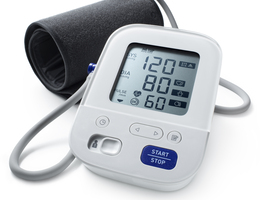
Dec. 14, 2023—Monitoring your blood pressure at home is a good way for you to take an active role in your health. And if you're one of the nearly 50% of all American adults who have high blood pressure, or hypertension, it can help you and your doctor manage your condition.
But seemingly minor missteps can throw off blood pressure measurements—making it harder to get an accurate picture of how well you're managing your blood pressure, says the American Heart Association (AHA).
Here are five common monitoring mistakes—and tips to help you avoid them, based on advice from the AHA and the American Academy of Family Physicians (AAFP).
1. Choosing an inaccurate device.
When it comes to measuring blood pressure at home, there are a lot of options available. But even if a company claims its device is FDA-cleared, that doesn't mean it's a good choice. The FDA doesn't regulate the accuracy of home blood pressure devices.
What you can do: Ask your doctor which type of blood pressure measurement device you should use. The AHA recommends using a validated device for the most accurate results. You can search for one at validatebp.org.
After you buy a device, it's a good idea to have your doctor check it. Then bring it back in to be checked every year, says the AAFP.
2. Using the wrong cuff size.
Arm-cuff devices are a good option, says the AHA. But only if the cuff is sized correctly. If your arm is larger or thinner than the cuff was built for, you may not get good results.
In one study, people who used a cuff that was too small for their arm had readings up to 20 mm Hg higher, reports the AHA. When using a too-large cuff, the devices missed detecting high blood pressure 22% of the time.
What you can do: Ask your doctor or pharmacist to help you select the correct size. The cuff, which fits around your upper arm, should fit snugly enough that you can slide a finger between it and your arm.
Wrap the cuff around your bare skin, not a sleeve. Clothing can throw off a blood pressure reading by up to 50 mm Hg.
3. Rushing the reading.
When life gets busy, it might be tempting to take a quick reading in the midst of your daily hustle. But your activities, state of mind, and what you eat and drink can all affect your results.
Even talking can raise your blood pressure. So can listening: According to the AHA, active listening can raise blood pressure by 10 mm Hg.
What you can do: Before your reading, avoid caffeine and smoking, if you smoke. Don't exercise or eat for 30 minutes beforehand. Visit the bathroom. Finally, sit quietly for five minutes without any distractions. That includes television, music, books, news or your phone.
4. Changing the timing.
Blood pressure changes throughout the day. It's usually highest in the morning and lower in the evening. If you measure in the morning one day and just before bedtime the next, the difference may be misleading.
What you can do: Ask your doctor when and how often to monitor your blood pressure. They may suggest measuring your blood pressure first thing in the morning and again before dinner. Try to stick to the same times each day, and note the time when you record your results.
5. Picking the wrong position.
Crossing your legs, leaning forward and even holding your arm up to be measured—these can all throw off your results. Even the arm you measure matters, according to the AHA.
What you can do: Sit in a chair that supports your back. Keep your legs uncrossed and your feet flat on the floor.
Place the cuff so the bottom edge is 1 inch above your elbow crease. Keep your upper arm at about the level of your heart and prop it up on a flat surface, such as a table or countertop, to support its weight.
Once you're done, keep sitting quietly for one to two minutes. Then take a second reading.
Under pressure?
Monitoring your blood pressure can be challenging, but you don't have to go it alone. Ask your healthcare provider for help and advice. They can help you measure your blood pressure correctly—and help you understand how your blood pressure might affect your health.
Sources
- American Academy of Family Physicians. "Blood Pressure Monitoring at Home." https://familydoctor.org/blood-pressure-monitoring-at-home/.
- American Heart Association. "Are Blood Pressure Measurement Mistakes Making You Chronically Ill?" https://www.heart.org/en/news/2018/05/10/are-blood-pressure-measurement-mistakes-making-you-chronically-ill.
- American Heart Association. "Are You Taking Pressure in Both Arms? You Should, Study Finds." https://www.heart.org/en/news/2022/08/03/are-you-taking-blood-pressure-in-both-arms-you-should-study-finds.
- American Heart Association. "Blood Pressure Measurements in the Clinic May Vary Widely Between Doctor's Visits." https://www.heart.org/en/news/2023/03/08/blood-pressure-measurements-in-the-clinic-may-vary-widely-between-doctors-visits.
- American Heart Association. "Monitoring Blood Pressure at Home Can Be Tricky – Here's How to Do It Right." https://www.heart.org/en/news/2022/05/23/monitoring-blood-pressure-at-home-can-be-tricky-heres-how-to-do-it-right.
- American Heart Association. "When It Comes to Accurate Blood Pressure Readings, Cuff Size Matters." https://www.heart.org/en/news/2022/03/01/when-it-comes-to-accurate-blood-pressure-readings-cuff-size-matters.
- Centers for Disease Control and Prevention. "Measure Your Blood Pressure." https://www.cdc.gov/bloodpressure/measure.htm.